英语作文评价量规表
- 格式:docx
- 大小:12.11 KB
- 文档页数:1
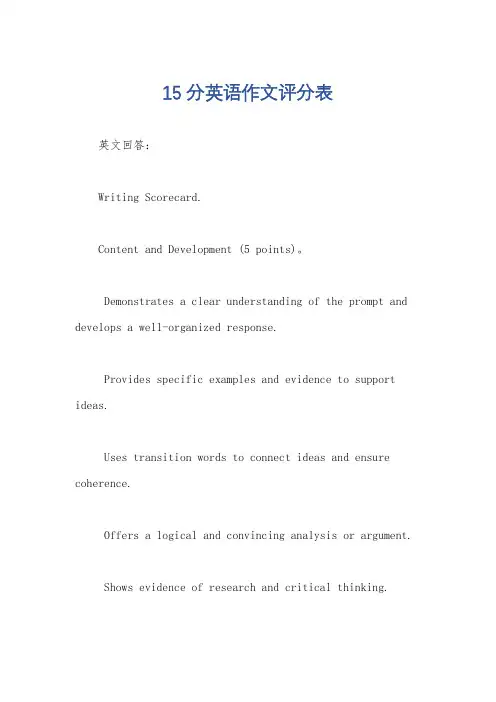
15分英语作文评分表英文回答:Writing Scorecard.Content and Development (5 points)。
Demonstrates a clear understanding of the prompt and develops a well-organized response.Provides specific examples and evidence to support ideas.Uses transition words to connect ideas and ensure coherence.Offers a logical and convincing analysis or argument.Shows evidence of research and critical thinking.Organization (3 points)。
Presents a clear introduction, body paragraphs, and conclusion.Uses headings or subheadings to organize information effectively.Follows a logical flow of ideas and maintains focus throughout the writing.Transitions smoothly between paragraphs.Uses signposting words and phrases to guide the reader.Style and Language (3 points)。
Uses appropriate vocabulary and sentence structure.Demonstrates command of grammar and mechanics.Employs effective writing techniques (e.g., vividimagery, sensory details, parallel structure).Varies sentence length and structure to create rhythm and interest.Avoids unnecessary repetition and wordiness.Conventions (2 points)。
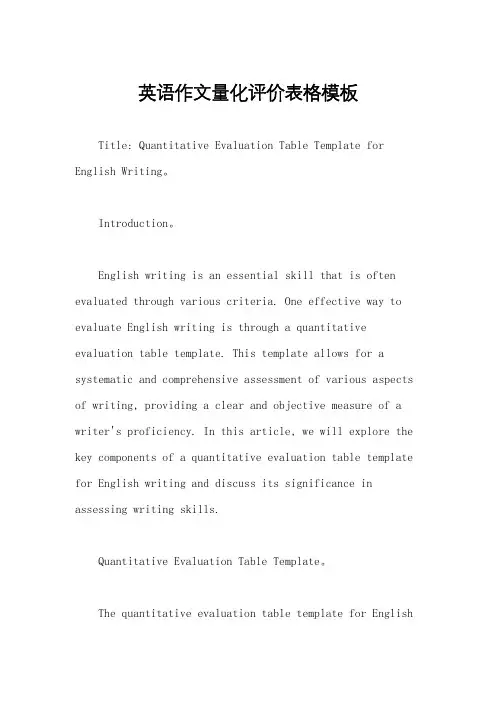
英语作文量化评价表格模板Title: Quantitative Evaluation Table Template for English Writing。
Introduction。
English writing is an essential skill that is often evaluated through various criteria. One effective way to evaluate English writing is through a quantitative evaluation table template. This template allows for a systematic and comprehensive assessment of various aspects of writing, providing a clear and objective measure of a writer's proficiency. In this article, we will explore the key components of a quantitative evaluation table template for English writing and discuss its significance in assessing writing skills.Quantitative Evaluation Table Template。
The quantitative evaluation table template for Englishwriting typically includes several key components that are used to assess the quality of a piece of writing. These components may include:1. Grammar and Mechanics: This section evaluates the writer's command of grammar, punctuation, and spelling. It assesses the accuracy and correctness of the language used in the writing.2. Vocabulary and Word Choice: This section focuses on the writer's use of vocabulary and the appropriateness of word choice. It evaluates the richness and precision of the language used in the writing.3. Organization and Structure: This section assesses the overall organization and structure of the writing. It looks at the coherence and logical flow of ideas, as well as the effectiveness of the introduction, body, and conclusion.4. Content and Development: This section evaluates the depth and relevance of the content. It assesses thewriter's ability to develop and support ideas, provide evidence, and maintain a clear focus throughout the writing.5. Style and Tone: This section focuses on the writer's style and tone. It evaluates the writer's ability to convey a specific tone or voice, as well as the overall style and expression of the writing.Significance of Quantitative Evaluation Table Template。
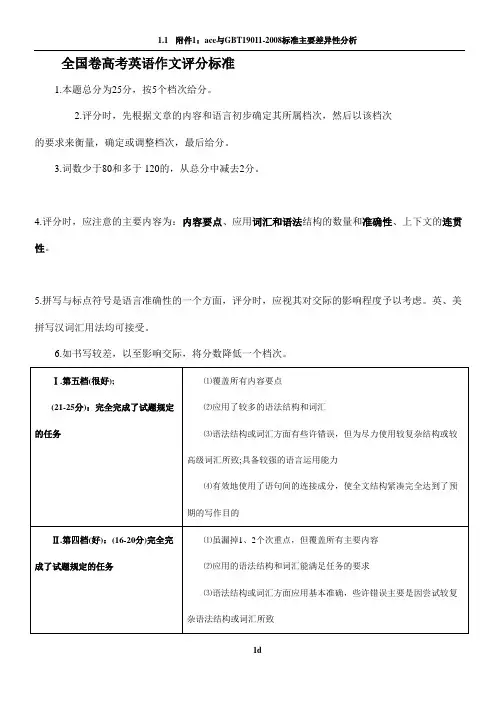
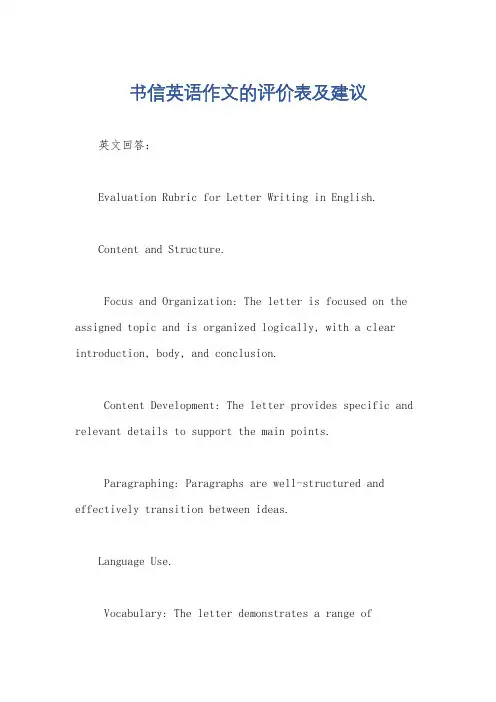
书信英语作文的评价表及建议英文回答:Evaluation Rubric for Letter Writing in English.Content and Structure.Focus and Organization: The letter is focused on the assigned topic and is organized logically, with a clear introduction, body, and conclusion.Content Development: The letter provides specific and relevant details to support the main points.Paragraphing: Paragraphs are well-structured and effectively transition between ideas.Language Use.Vocabulary: The letter demonstrates a range ofappropriate vocabulary relevant to the topic.Grammar: The letter is grammatically accurate, with correct sentence structure and verb tenses.Fluency: The letter is written in a clear and concise style, using appropriate transitions and avoiding repetition.Mechanics.Formatting: The letter is properly formatted with correct margins, spacing, and indentation.Punctuation: The letter uses appropriate punctuation to enhance clarity and meaning.Spelling: All words are spelled correctly.Recommendation.To improve your letter writing skills in English,consider the following suggestions:Brainstorm and Plan: Before writing, take time to generate ideas and outline the structure of your letter.Use Specific and Relevant Details: Support your main points with specific examples and evidence.Organize Paragraphs Effectively: Each paragraph should focus on a particular idea or aspect of the topic.Expand Vocabulary: Read widely and incorporate new words into your writing.Review Grammar Rules: Ensure you understand basic grammar principles and apply them correctly.Get Feedback: Ask a teacher, classmate, or native speaker to review your writing and provide constructive criticism.中文回答:书信英语作文评价表。
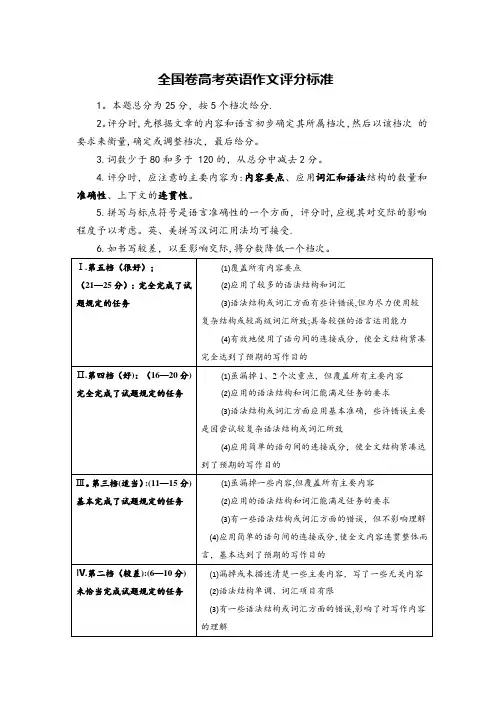
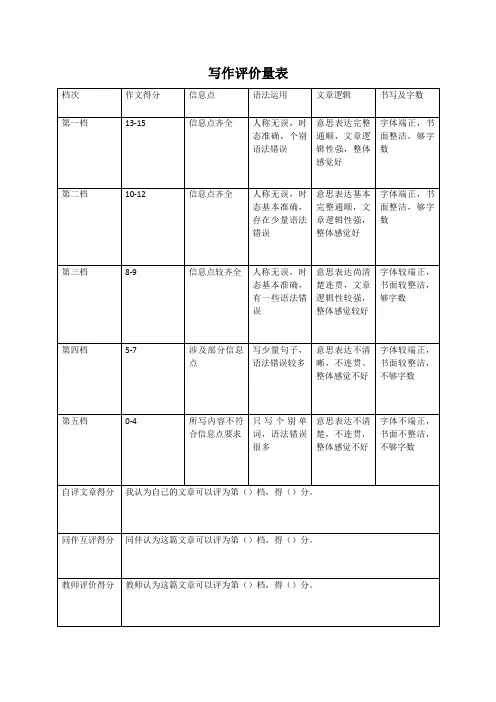
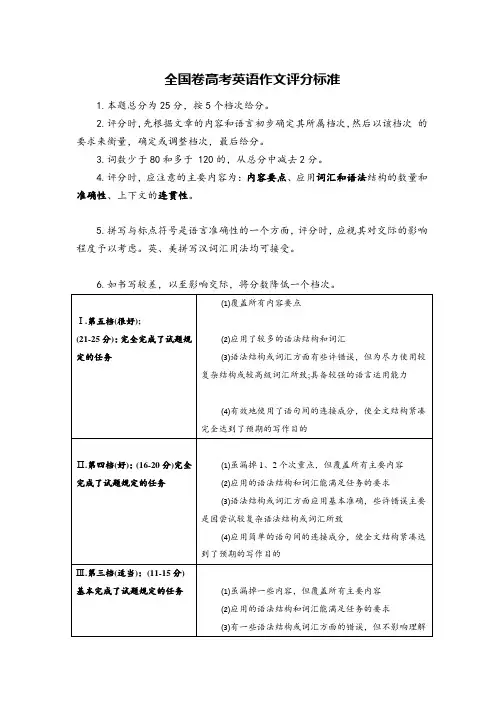
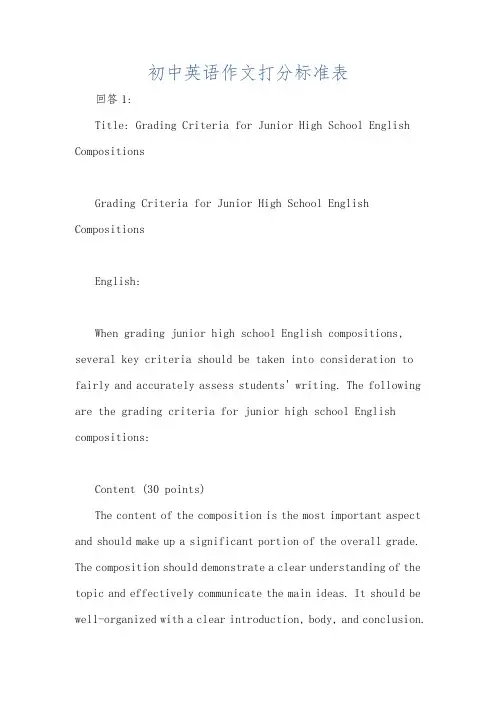
初中英语作文打分标准表回答1:Title: Grading Criteria for Junior High School English CompositionsGrading Criteria for Junior High School English CompositionsEnglish:When grading junior high school English compositions, several key criteria should be taken into consideration to fairly and accurately assess students' writing. The following are the grading criteria for junior high school English compositions:Content (30 points)The content of the composition is the most important aspect and should make up a significant portion of the overall grade. The composition should demonstrate a clear understanding of the topic and effectively communicate the main ideas. It should be well-organized with a clear introduction, body, and conclusion.Additionally, the content should be relevant, insightful, and demonstrate critical thinking.Language Use (25 points)Language use is crucial in evaluating a student's English composition. The writing should display a good command of vocabulary, grammar, and sentence structure appropriate for the student's level. The use of varied and sophisticated vocabulary, as well as accurate and complex sentence structures, should be rewarded.Coherence and Cohesion (20 points)The composition should exhibit a logical sequence of ideas with smooth transitions between sentences and paragraphs. The overall coherence and cohesion of the writing should be emphasized, as it contributes to the overall quality of the composition.Creativity (15 points)Originality and creativity should be valued in students' compositions. The ability to present ideas in an imaginative and engaging manner should be recognized and rewarded. Creativeuse of language and unique perspectives should be encouraged and acknowledged.Mechanics (10 points)Mechanics, including spelling, punctuation, and formatting, play a role in the overall presentation of the composition. While not as heavily weighted as other criteria, attention to detail and accuracy in mechanics should still be assessed.Overall ImpressionIn addition to the specific grading criteria listed above, overall impression should also be taken into account. Awell-written composition that leaves a strong impact on the reader should be recognized and reflected in the final grade.These grading criteria provide a comprehensive framework for evaluating junior high school English compositions, ensuring that students' writing abilities are thoroughly and fairly assessed.Chinese:初中英语作文打分标准初中英语作文打分标准对于公平和准确地评估学生的写作能力来说非常重要。
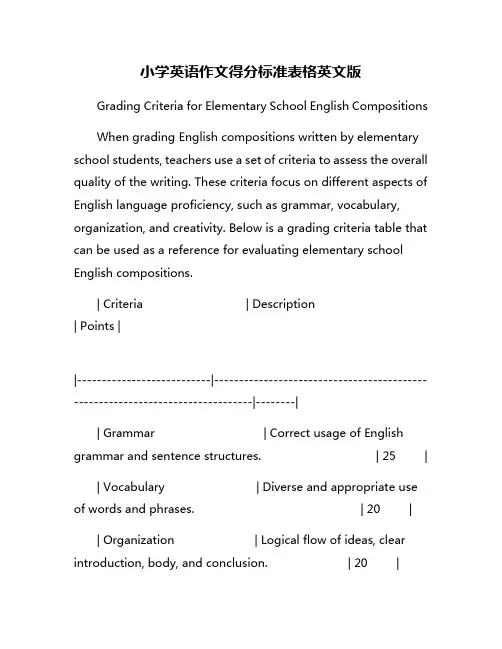
小学英语作文得分标准表格英文版Grading Criteria for Elementary School English CompositionsWhen grading English compositions written by elementary school students, teachers use a set of criteria to assess the overall quality of the writing. These criteria focus on different aspects of English language proficiency, such as grammar, vocabulary, organization, and creativity. Below is a grading criteria table that can be used as a reference for evaluating elementary school English compositions.| Criteria | Description| Points ||---------------------------|-------------------------------------------------------------------------------|--------|| Grammar | Correct usage of English grammar and sentence structures. | 25 || Vocabulary | Diverse and appropriate use of words and phrases. | 20 || Organization | Logical flow of ideas, clear introduction, body, and conclusion. | 20 || Creativity | Originality and creativity in expressing ideas and thoughts. | 15 || Clarity and Coherence | Clarity of expression and coherence in connecting ideas. | 10 || Spelling and Punctuation | Accurate spelling and appropriate use of punctuation marks. | 10|Total Points: 100Each criterion is assigned a certain number of points, and the total points add up to 100. Teachers can use this table to provide feedback to students on their compositions and help them understand where they need to improve. By focusing on these key areas, students can enhance their English writing skills and become more proficient in expressing themselves in written form.Grading compositions can be a subjective process, but having a clear set of criteria can help ensure consistency and fairness in assessment. Teachers may also provide specific feedback on areas that need improvement, along with suggestions for further practice and development. With consistent practice and guidance, elementary school studentscan improve their English writing skills and become more confident in their abilities to communicate effectively in written form.。
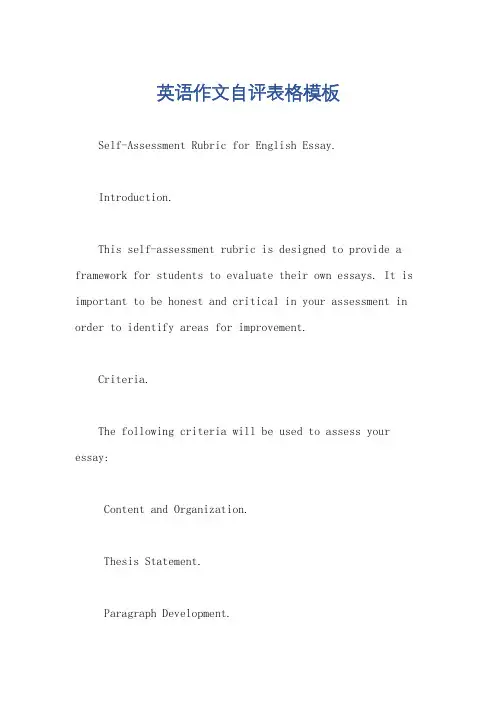
英语作文自评表格模板Self-Assessment Rubric for English Essay.Introduction.This self-assessment rubric is designed to provide a framework for students to evaluate their own essays. It is important to be honest and critical in your assessment in order to identify areas for improvement.Criteria.The following criteria will be used to assess your essay:Content and Organization.Thesis Statement.Paragraph Development.Sentence Structure.Vocabulary.Grammar and Mechanics.Scoring.Each criterion will be scored on a scale of 1-5, with 5 being the highest score.Instructions.Please read through each criterion carefully and provide a score for your essay. Be sure to provide specific examples to support your评分.Scoring Rubric.Content and Organization.1. Does the essay have a clear and focused thesis statement?2. Is the essay well-organized and easy to follow?3. Are the paragraphs well-developed and supported with evidence?4. Does the essay provide a strong conclusion that summarizes the main points?Thesis Statement.1. Is the thesis statement clear and concise?2. Does the thesis statement accurately reflect the content of the essay?3. Is the thesis statement supported by evidence throughout the essay?Paragraph Development.1. Do the paragraphs have a clear topic sentence?2. Are the paragraphs well-developed and supported with evidence?3. Do the paragraphs flow smoothly from one to the next?Sentence Structure.1. Are the sentences grammatically correct?2. Are the sentences varied in length and structure?3. Are the sentences clear and concise?Vocabulary.1. Is the vocabulary appropriate for the audience and purpose of the essay?2. Are the words used correctly?3. Is the vocabulary varied and interesting?Grammar and Mechanics.1. Is the essay free of grammatical errors?2. Is the essay free of spelling errors?3. Is the essay formatted correctly?Comments.In addition to the scoring, please provide any other comments or suggestions that you have for improving your essay.中文回答。
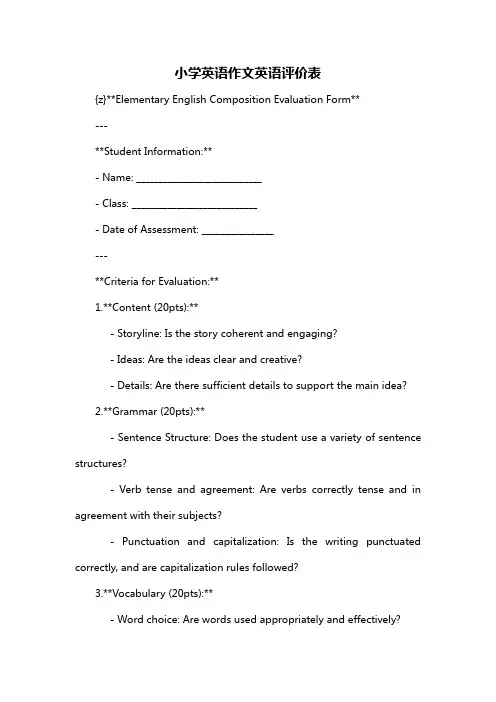
小学英语作文英语评价表{z}**Elementary English Composition Evaluation Form**---**Student Information:**- Name: ____________________________- Class: ____________________________- Date of Assessment: ________________---**Criteria for Evaluation:**1.**Content (20pts):**- Storyline: Is the story coherent and engaging?- Ideas: Are the ideas clear and creative?- Details: Are there sufficient details to support the main idea?2.**Grammar (20pts):**- Sentence Structure: Does the student use a variety of sentence structures?- Verb tense and agreement: Are verbs correctly tense and in agreement with their subjects?- Punctuation and capitalization: Is the writing punctuated correctly, and are capitalization rules followed?3.**Vocabulary (20pts):**- Word choice: Are words used appropriately and effectively?- Variety: Does the student use a range of vocabulary?- Sentence Fluency: Does the student use interesting words to create fluent sentences?4.**Spelling and Punctuation (15pts):**- Are words spelled correctly?- Is punctuation used correctly, including dialogue and lists?5.**Conventions (10pts):**- Does the student use a title and proper margins?- Are paragraphs used appropriately?- Is the essay organized with an introduction, body, and conclusion?6.**Complete Sentences (10pts):**- Are all sentences complete and well-structured?7.**Handwriting (5pts):**- Is the handwriting legible and neat?---**Total Points: 100pts**---**Evaluator"s Comments:**[Evaluator"s Signature: ____________________]---**Student"s Reflection:**[Student"s Signature: ____________________][Date: ____________________________]---**Note to Teacher:**[Additional comments or feedback for the teacher]---This evaluation form is designed to provide a comprehensive assessment of a student"s English composition skills, focusing on various aspects such as content, grammar, vocabulary, spelling, punctuation, conventions, sentence structure, and handwriting.It aims to encourage students to develop their language skills while providing them with constructive feedback to improve their writing abilities.。
英语作文评价表Title: English Essay Evaluation Form。
Name: [Student's Name]Date: [Date of Submission]Introduction:The introduction effectively introduces the topic and provides clear context for the essay.Content & Development:1. Thesis Statement: Is the thesis statement clear and focused? Does it provide a roadmap for the essay?2. Supporting Points: Are the main points clearly articulated and adequately supported with evidence or examples?3. Organization: Does the essay have a logical structure with smooth transitions between paragraphs and ideas?4. Depth of Analysis: Does the essay demonstrate critical thinking and analysis of the topic? Are arguments well-developed and insightful?Language & Style:1. Clarity: Is the language clear and easy to understand? Are complex ideas expressed in a straightforward manner?2. Coherence: Are sentences and paragraphs well-connected, leading to a smooth flow of ideas?3. Conciseness: Does the writer avoid unnecessary repetition or wordiness? Is the writing concise and to the point?4. Vocabulary: Does the writer demonstrate a strong command of vocabulary appropriate for the topic and audience?5. Tone: Is the tone appropriate for the purpose and audience of the essay? Does it maintain professionalism and respectfulness?Mechanics & Conventions:1. Grammar: Are there any grammatical errors or awkward constructions that impede understanding?2. Punctuation: Are punctuation marks used correctly and consistently throughout the essay?3. Spelling: Are there any spelling errors or typosthat detract from the overall quality of the writing?4. Formatting: Is the essay formatted according to the guidelines provided? (Font, spacing, margins, etc.)。
英语作文量化评价表模板Title: Quantitative Evaluation Table Template for English Composition。
Introduction。
In order to effectively evaluate and assess English compositions, a quantitative evaluation table template can be used. This template provides a structured and systematic approach to assessing various aspects of an English composition, including content, organization, language use, and mechanics. By using this template, teachers, students, and writers can objectively measure the quality of a composition and identify areas for improvement.Content。
The content section of the quantitative evaluation table template focuses on the relevance, accuracy, and depth of the information presented in the composition. It assesses whether the content is appropriate for the intended audience and purpose, and whether it effectively conveys the main ideas and supporting details. The content section may include criteria such as the clarity of the thesis statement, the development of ideas, the use of evidence and examples, and the overall coherence of the composition.Organization。
作文评分表英文1. The essay demonstrates a good understanding of the topic and effectively conveys the writer's thoughts and ideas. The language used is clear and concise, making it easy for the reader to follow along.2. The writer effectively utilizes a variety of vocabulary and sentence structures to express their ideas, which adds depth and complexity to the essay. This demonstrates a strong command of the English language.3. The essay shows a strong ability to organize and present ideas in a coherent manner. The writer effectively transitions between different points and maintains a clear focus throughout the essay.4. The writer demonstrates a strong ability to support their arguments with relevant evidence and examples. This adds credibility to the essay and shows a thoughtful approach to the topic.5. The essay effectively engages the reader and maintains their interest throughout. The writer's voice is compelling and adds a personal touch to the essay.6. The essay effectively addresses any potential counterarguments and provides a well-reasoned response. This demonstrates a thoughtful and nuanced understanding of the topic.7. The conclusion effectively summarizes the main points and leaves a lasting impression on the reader. It provides a sense of closure while also encouraging further reflection on the topic.。
初中英语作文评分等级表Composition Scoring Rubric for Junior High School EnglishLevel 5 - Excellent (25-30 points)- The composition demonstrates a high level of proficiency in English.- The content is creative, well-organized, and provides in-depth development of the topic.- The essay has a clear and compelling thesis statement.- Sentences are well-structured, varied in length and complexity, and free from grammatical errors.- Vocabulary usage is extensive and accurate, with appropriate idiomatic expressions.- Punctuation and spelling are flawless.- The composition effectively engages the reader and displays advanced writing skills.Level 4 - Good (20-24 points)- The composition shows a good level of English proficiency.- The content is well-organized and develops the topic adequately.- The essay has a clear thesis statement, although it may not be as compelling as in Level 5.- Sentences are generally well-structured, with some variety in length and complexity.- Vocabulary usage is appropriate, with a few errors in word choiceor idiomatic expressions.- Punctuation and spelling errors are minimal and do not detract from the overall quality.- The composition is engaging and demonstrates competent writing skills.Level 3 - Fair (15-19 points)- The composition indicates a moderate level of English proficiency.- The content is somewhat organized, but may lack depth in the development of the topic.- The essay's thesis statement may be present but is not clearly articulated.- Sentences are mostly simple and may lack variety or show some grammatical errors.- Vocabulary usage is adequate, but with some errors in word choice or idiomatic expressions.- Punctuation and spelling contain some errors, which may slightly hinder comprehension.- The composition is generally coherent but lacks engagement and sophistication in writing style.Level 2 - Poor (10-14 points)- The composition reflects a low level of English proficiency.- The content is poorly organized, with limited development of thetopic.- The essay lacks a clear thesis statement.- Sentences are simple and often contain grammatical errors.- Vocabulary usage is limited, with frequent errors in word choice or idiomatic expressions.- Punctuation and spelling are problematic, which can impede comprehension.- The composition is difficult to follow and shows weak writing skills.Level 1 - Very Poor (0-9 points)- The composition shows a very low level of English proficiency.- The content is disorganized, lacking a clear focus and development of the topic.- Sentences are often incoherent and filled with grammatical errors.- Vocabulary usage is inadequate, with significant errors in word choice and idiomatic expressions.- Punctuation and spelling are rampant, making the composition difficult to understand.- The essay lacks structure, clarity, and demonstrates a lack of basic writing skills.。
写景英语作文评价标准表Evaluation Rubric for Descriptive Landscape Writing.Content and Organization.Accuracy and Specificity: The writing accurately and vividly depicts the landscape, using specific sensory details and descriptive language.Scope and Depth: The writing covers a comprehensive range of landscape elements, exploring both general features and individual details.Organization: The writing is well-organized, with a clear structure and logical progression of ideas.Sensory Description.Visual Imagery: The writing creates a vivid visual impression of the landscape, using descriptive words thatappeal to the sense of sight.Auditory Description: The writing effectively captures the sounds of the landscape, using devices such as onomatopoeia and alliteration.Tactile and Kinesthetic Description: The writingevokes sensations of touch and movement, allowing thereader to experience the landscape physically.Olfactory and Gustatory Description: The writing incorporates scents and flavors to enhance the reader's sensory experience of the landscape.Language and Style.Figurative Language: The writing uses figurative language, such as metaphors, similes, and personification,to create vivid and original descriptions.Literary Devices: The writing employs literary devices, such as parallelism, antithesis, and repetition, to createrhythm and emphasis.Sentence Structure: The writing varies sentence length and structure to maintain reader interest and create a natural flow.Word Choice: The writing uses precise and evocative vocabulary, choosing words that are both descriptive and meaningful.Mood and Atmosphere.Sensory Immersion: The writing immerses the reader in the sensory details of the landscape, evoking a vivid and memorable atmosphere.Emotional Impact: The writing conveys the emotional impact of the landscape, whether it evokes a sense of awe, tranquility, or any other emotion.Symbolism and Metaphor: The writing may use symbolism and metaphor to suggest deeper meanings or connectionswithin the landscape.Overall Impression.Originality and Creativity: The writing presents unique and unexpected perspectives on the landscape, offering fresh and thought-provoking insights.Flow and Readability: The writing is engaging and easy to read, with a smooth flow that keeps the reader interested.Depth of Understanding: The writing demonstrates a deep understanding and appreciation of the landscape, revealing the author's personal connection to the environment.。